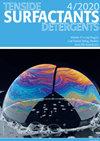综述了环保型脂肪酸聚甘油酯的研究进展、合成及应用
IF 1.2
4区 工程技术
Q4 CHEMISTRY, APPLIED
引用次数: 0
摘要
聚甘油酯(peg)是一种非离子表面活性剂,具有乳化剂、润湿剂和粘度调节剂的作用,广泛应用于化妆品、制药和食品工业。由于安全性问题,它们已被提议作为乙氧基化乙二醇基非离子表面活性剂的替代品。PGEs由脂肪酸(亲脂部分)和聚甘油(亲水部分)组成。它们的合成方法有脂肪酸与聚甘油直接酯化法、脂肪酸甲酯与聚甘油化学酯交换法、Lipozyme 435酶促酯交换法、以碳酸甘油为原料、微波辐照法等。聚甘油酯(PGEs)被认为是化学工业中现有乳化剂的绿色替代品,因为用于合成的原料是从可再生的植物油中获得的,因此是一种环保的表面活性剂,广泛应用于食品、化妆品、纺织品和个人护理等领域。合成聚甘油脂肪酸酯的主要挑战是提高收率和控制酯化水平,同时尽量减少副反应。本文章由计算机程序翻译,如有差异,请以英文原文为准。
An overview on eco-friendly polyglycerol esters of fatty acid, synthesis and applications
Abstract Polyglycerol esters (PEGs) which are non-ionic surfactants acting as emulsifiers, wetting agents and viscosity modifying agents are used in the cosmetic, pharmaceutical and food industries. They have been proposed as an alternative to ethoxylated glycol-based non-ionic surfactants due to safety issues. PGEs are composed of fatty acid, which is a lipophilic moiety, and polyglycerol, which is a hydrophilic moiety. They are synthesized by several methods, such as direct esterification of fatty acids and polyglycerols, chemical transesterification of fatty acid methyl esters and polyglycerol, enzymatic transesterification using Lipozyme 435, using glycerol carbonate as raw material, using microwave irradiation, etc. PGEs (Polyglycerol esters) are claimed to be green alternatives to the existing emulsifiers used in the chemical industry as the raw material used for synthesis is obtained from vegetable oils which are renewable, and therefore, eco-friendly surfactants for use in a broad number of applications including food, cosmetics, textiles and personal care. The major challenges in the synthesis of polyglycerol fatty acid esters are to increase yield and control the esterification level while minimising side reactions.
求助全文
通过发布文献求助,成功后即可免费获取论文全文。
去求助
来源期刊

Tenside Surfactants Detergents
工程技术-工程:化工
CiteScore
1.90
自引率
10.00%
发文量
57
审稿时长
3.8 months
期刊介绍:
Tenside Surfactants Detergents offers the most recent results of research and development in all fields of surfactant chemistry, such as: synthesis, analysis, physicochemical properties, new types of surfactants, progress in production processes, application-related problems and environmental behavior. Since 1964 Tenside Surfactants Detergents offers strictly peer-reviewed, high-quality articles by renowned specialists around the world.
 求助内容:
求助内容: 应助结果提醒方式:
应助结果提醒方式:


